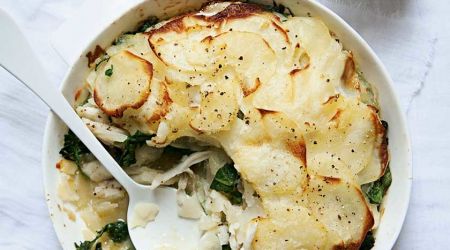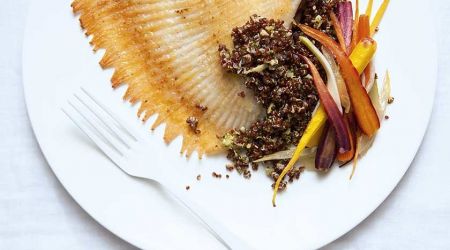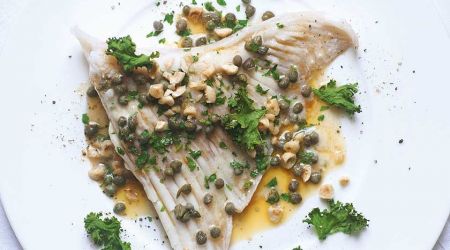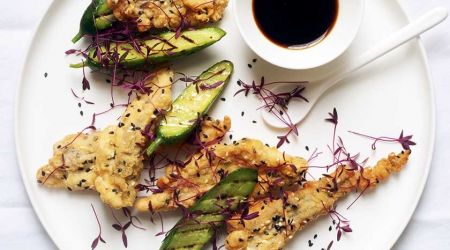Skate
It might have an identity crisis, a friendly face and a spot on the danger list, but at this time of year you can enjoy the delicate flavour of this fish guilt-free, says Clarissa Hyman
The story of the skate is one of sex, violence and horror. Perhaps that’s only to be expected of a fish that can claim the shark as a cousin. And just like its bigger, badder relative, the skate (and fellow/interchangeable batoid, the ray) is a boneless wonder, possessing instead a cartilaginous skeleton, as well as menacing, undulating pectoral fins that propel it through the water and are so large in proportion they’re referred to as ‘wings’.
As if that wasn’t sufficiently unnerving, the diamond-shaped skate, with its long, whip-like tail, also comes with a set of armaments that could double as weapons of mass destruction; spikes and thorns protruding from the tough, leathery exterior protect the fish from predators. As a result, if it finds its way into the kitchen, attempting to remove the skin from the flesh usually requires a pair of pliers, and comes with a serious risk of injury from one of those spikes. It’s a job strictly for those who are strong and brave enough to attempt it; while it’s less about skill than sheer resolve and determination, my advice is to leave it to the professionals and the ample skills of your fishmonger.
Just to add to the fear factor, the underside of a skate or ray can look disturbingly like a human face. So much so, that in 16th-century Belgium it became a thing to carve out the belly of the fish to resemble a shrivelled body. This carcass would then be preserved, varnished and passed off as a small sea devil or monster. They were known as jeune d’Anvers (literally, ‘young person of Antwerp’), which was in turn anglicised to ‘Jenny Hanivers’ by British sailors who brought them home to their families. (If you haven’t already Google-imaged this, please do so now.)
Sex on the seabed is also a pretty rough affair, in which the male skate (a bit smaller than the female) grips his chosen one tightly, often by the teeth as well as his ferocious claspers. Mating can go on for some time, but the fertilised eggs won’t appear for a month, when the female lays them ready-packed into a horny capsule known as a mermaid’s purse. These purses have a filament at each corner that grips on to something solid to stop the eggs from being swept away. The juveniles are about six months old and 10cm long when they hatch and swim forth to face the world.
And now we need to talk about the smell. Please excuse the potty talk, but there’s no getting away from the fact that they can have a distinct whiff of the brick outhouse. Skate store large amounts of urea (basically, er, urine) in their tissues, which protects them from the salt in the sea and controls their osmotic balance. When they’re caught and killed, the urea starts to leech out and then break down, producing ammonia – complete with its own very special fragrance. This is, however, a good thing. The doubtful consumer needs to remember that some smell is natural and indicates the welcome disappearance of the urea. In fact, ray and skate are best when not eaten freshly caught, as it takes about 48 hours for the beneficial chemical changes to occur. Before then, the flesh can be tough and tasteless. However, the smell and the ammonia itself should disappear quickly during cooking, and one can enjoy flesh that is meaty, sweet, tender and lean with an easy-to-eat softly-corrugated texture.
According to The Oxford Companion to Food, ray and skate belong to the Rajidae family and the names are interchangeable; there is no biological basis for using one in preference to the other, although the larger fish with long snouts tend to be called skate, while rays are smaller with rounded heads.
The best for eating is held to be Raja clavata, the thornback ray (described in parts of the UK and Ireland simply as skate; it is also known as roker in East Anglia). Other ray/skate found in European waters include Raja montagui, or the spotted ray, with pretty, dark freckles on its back, and Raja radiata or starry ray – native to more Arctic regions. In 2009, research found that the common skate, Raja batis – identified in 1758 – was actually two separate species: the flapper skate, Raja intermedia, and the blue skate, Raja flossada. On the fishmonger’s slab, however, it’s hard to distinguish the varieties as they all look similar when skinned and cut.
Skate and ray tend to sit camouflaged and buried in the sand on the seabed, waiting for prey to pass them by. To do so, they have evolved a fiendishly cunning way of breathing without opening their mouths. They use a vent on their top side, which allows water to pass over their gills and provide oxygen.
Skate were once numerous around the British Isles, but populations are now broadly restricted to the deep-sea lochs of western Scotland and the west coast of Ireland. Decades of overfishing, especially by boat anglers who would throw them back dead into the sea after posing with them for celebratory selfies, put them firmly on the endangered list. Happily, both recreational and professional fishermen are now far more aware of the importance of conserving the species, and take part in tagging programmes. Nonetheless, the MSC’s advice is to avoid the common skate.
The thornback ray, caught off Cornwall and the Bristol Channel is slightly less vulnerable according to current marine council assessment. Depending on how and where it is found, the spotted ray varies between sustainable and unsustainable, and the MSC suggests always buying from sources that can assure the consumer of provenance and good fishery management.
Raie au beurre noir (skate in black butter sauce) is one of the great classic fish dishes, in which the tart and salty taste of capers pairs perfectly with the tender fish, made luscious with lashings of butter and a healthy spritz of lemon juice. Delicate skate fillets or wings can also be poached in wine or floured and browned with butter. Cookery writer Sophie Grigson suggests a delicious variation that adds spices, including crushed peppercorns, coriander seeds and dried oregano to the coating flour.
And with its naturally gelatinous sticky and pleasing firm texture, it’s perfect for a terrine. Skate cheeks – also known as ‘knobs’ – are nuggets cut from the body section of the skate or ray after the wings are removed. Normally they get thrown away, but they are easily as delicious as cod or monkfish cheeks.
Skate or ray. Ray or skate. They’re the Twin Peaks of the marine world: mysterious, scary and simply seductive.
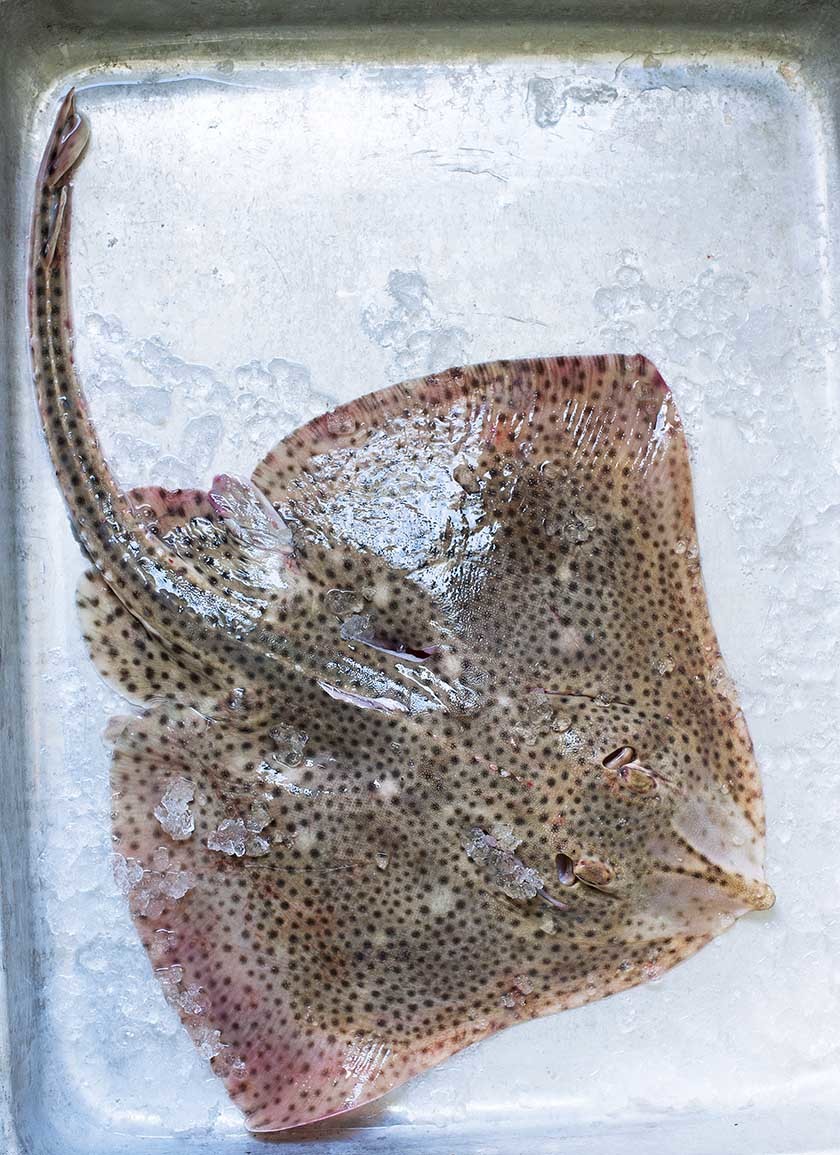
Recipes
Get Premium access to all the latest content online
Subscribe and view full print editions online... Subscribe

